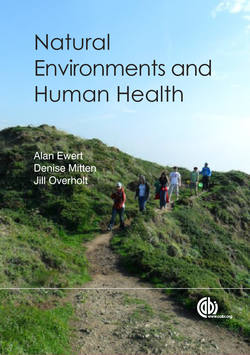Читать книгу Natural Environments and Human Health - Alan W Ewert - Страница 13
На сайте Литреса книга снята с продажи.
Structure of this Book
ОглавлениеHistorically, there has been much discussion and accompanying literature focused on the role that nature plays in human welfare. Only recently, however, with both the debate over climate change and the 2005 publishing of Louv’s book Last Child in the Woods, has the discussion over the importance of natural environments for human well-being been rekindled. This issue is both timely and of critical importance to our society as we continue to define the role that natural environments will play for the health and well-being of future generations. Increasingly, there is recognition that these environments play a critical role in providing benefits such as stress reduction, healthy childhood development, mental health, enjoyment, aesthetics, and catharsis, rather than only in commodity production. This book examines the long history of natural environments being used in these non-commodity production ways and traces the development of the connection of humans to environments within the context of how they impact our personal and collective health. This information is presented in 11 chapters.
Chapter 1 provides an overview of the book by focusing on the intended audience, the underlying assumptions, and definition of commonly used terms. In Chapter 2, ‘Human Perceptions of Nature’, the discussion revolves around the ways that people’s attachment to the natural world is driven by perceptions as well as evolution and biology. Salient WorldViews of natural environments and health, and how these WorldViews impact individual and collective behaviors are identified. Finally, we reverse the direction of this discussion by examining the impact of a lack of natural settings upon health and, in particular, focus on modernity from the perspectives of society lacking a relationship of personally significant connection with the natural world, as well as the growing awareness of an ecological crisis and its impact on human health. Transitioning then to nature and health throughout history, Chapter 3, ‘The Historical Connection between Natural Environments and Health’, provides an overview of the history of the connection between human health and natural environments and how this connection has evolved and changed over time. Following this, we identify particular characteristics and attributes associated with human health that have been linked to natural settings.
In Chapter 4, we discuss a number of salient concepts and theories closely identified with human health and natural environments. This chapter is divided into five sections: (i) genetic theories; (ii) other evolutionary-grounded theories; (iii) psychological theories; (iv) restoration and restorative environments; and (v) intentionally designed experiences (IDEs). Genetic theories include naturalistic intelligence, the biophilia hypothesis, and indigenous consciousness. In the psychological theories section, identity and the natural environment, psychologically deep and extraordinary experiences, flow, the peak experience, and transcendent experiences are examined. The restoration and restorative environments section looks at psycho-evolutionary theory (PET) and attention restoration theory (ART).
The discussion on IDEs attempts to combine some of the extant theories such as PET with how specifically designed programs can increase the impact that natural environments can have on health-related issues such as stress or anxiety. That is, how can we develop health-enhancing experiences and programs using the psychological theories discussed in this chapter?
Chapter 5 focuses on the topic of ‘Human Development and Nature’. Specific attention is paid to the developmental process and myriad of ways that nature and natural environments can be used to enhance human development, particularly with a view towards positive health behaviors. Human development from birth through end-of-life stages is covered, combining developmental theory with the research about human health and natural environments. In Chapter 6, ‘Adaptations and Applications’, we examine health-related concepts such as folk biology, traditional ecological knowledge (TEK), friluftsliv, ecofeminism, and the socio-ecological approach to human health. Applications included in this chapter are nature medicines, conservation and the development of a land ethic, spirituality, and citizen science. A section of Chapter 6 describes the growing interest in ecotherapy and the broader field of ecopsychology.
Chapter 7 centers on the outcomes and benefits typically linked to human health and natural environments. Within this chapter, a broad range of activities, fields of study and settings are covered. Of major concern in this chapter is the research conducted in the area of human health and the natural environment and the specific outcome measures and documented benefits of spending time in nature. A sampling of documented benefits includes physical, psycho-emotional, spiritual, and social well-being. Included are suggestions for future research.
Chapter 8 discusses sense of place and the role of education in developing issues such as resilience, connection to nature, and building an environmental conscience. This chapter attempts to merge the reality of the positive impacts of natural environments on human health with the involvement of individuals, groups, and communities. Knowing that science provides a growing body of knowledge pointing to the value of natural environments for human health is important but insufficient if the individual does not either understand these effects or know how to apply them.
Chapter 9 looks at adventure and outdoor education programming as an example of an innovative approach for integrating natural environments and health. Chapter 10 expands on the ways to develop the connection between health and natural environments by focusing on how public policy might be developed in order to facilitate ways in which individuals can better access and benefit from natural landscapes. For example, these future actions might involve policy changes such as greenspace development, providing parks and other natural environments, and moving to make natural environments personally relevant. This chapter also examines the challenges and issues facing future research such as fidelity concerns, who will actually use the research findings, and how the issues of confounding variables will be dealt with.
The book ends with Chapter 11, ‘Resources’, and provides a collection of web sites, extant literature and other sources that speak to the connection between human health and natural environments.
